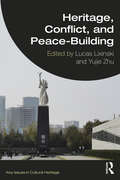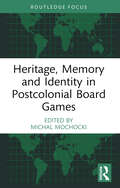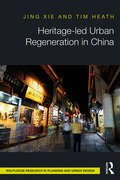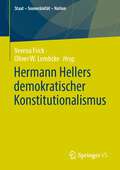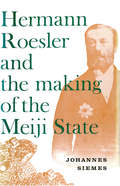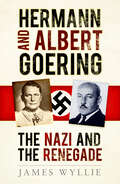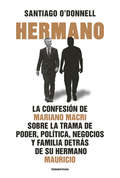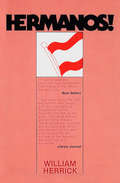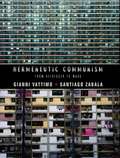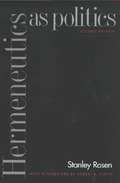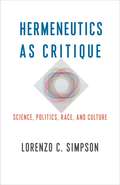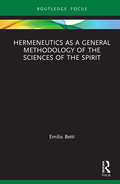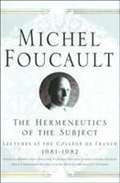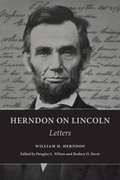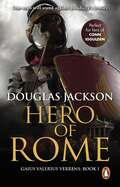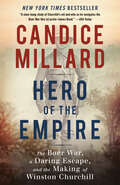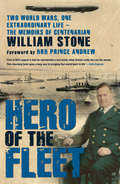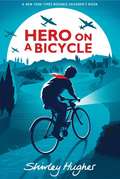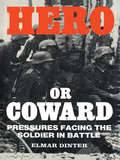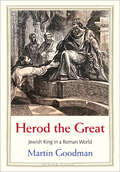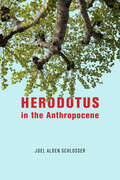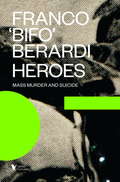- Table View
- List View
Heritage, Conflict, and Peace-Building (ISSN)
by Lucas Lixinski Yujie ZhuHeritage, Conflict, and Peace-Building examines the possibilities arising from, and challenges associated with, transforming heritage from a casualty of conflict into an opportunity for peacebuilding.The contributors to this book, who hail from academia and practice, present case studies that shed light on the multifaceted factors and conditions influenced by diplomacy, nationalism, victimhood, and the roles of diverse institutional actors in fostering peace. They demonstrate the possibilities and pitfalls of the work heritage does for local communities, the nation-state, and the international community, when these different actors and their peace aspirations and agendas intersect. Looking at heritage and peace processes on all continents, the contributions in this volume amount to a compelling analytical account of how the discourses of heritage and peace connect, overlap, and diverge. They also emphasise that our shared aspiration for peace should not be taken for granted in a heritage context, and that it is incumbent upon heritage scholars and practitioners to be more intentional about the work they wish to do to promote peace.Heritage, Conflict, and Peace-Building will be of interest to scholars and practitioners working in heritage studies, transitional justice, museum studies, international relations, education, history, and law.
Heritage, Memory and Identity in Postcolonial Board Games
by Michal MochockiHeritage, Memory and Identity in Postcolonial Board Games is a unique edited collection that explores the interplay of heritage, memory, identity and history within postcolonial board games and their surrounding paratexts. It also examines critiques of these games within the gamer communities and beyond. Drawing on a range of international contributions, examples and case studies, this book shows how colonialism-themed games work as representations of the past that are influenced by existing heritage narratives and discourses. It also considers the implications of using colonial histories in games and its impact on its audience, the games’ players. Heritage, Memory and Identity in Postcolonial Board Games will be relevant to scholars and postgraduate students in the fields of game studies, game design or development, heritage studies, postcolonial criticism, media studies, and history. It will also be beneficial to practicing game developers.
Heritage, Pilgrimage and the Camino to Finisterre
by Cristina Sánchez-CarreteroThis book presents research concerning the effects of the Camino to Finisterre on the daily lives of the populations who live along the route, and the heritagization processes that exploitation of the Camino for tourism purposes involves. Rather than focusing on the route to Santiago de Compostela and the pilgrimage itself, it instead examines a peculiar part of the route, the Camino to Finisterre, employing multiple perspectives that consider the processes of heritagization, the effects of the pilgrimage on local communities, and the motivations of the pilgrims. The book is based on a three-year research project and is the result of a multidisciplinary collaboration between anthropologists, sociologists, historians and archaeologists. Instead of ending in Santiago, as the rest of the Caminos do, this route continues to the cape of Finisterre on the Galician Atlantic coast. This part of the Camino de Santiago is not officially recognized by the Catholic Church and does not count as part of reaching Compostela, the recognition granted by the Catholic Church to those pilgrims who have walked at least 100 km. For this reason, as well as its relationship with the sun cult, many pilgrims call this route "the Camino of the atheists. " In fact, the Catholic Church is a strong force for the heritagization of the rest of the Caminos, and maintains a clear ignoratio strategy concerning the Finisterre route: Officially, the church neither opposes nor recognizes this route.
Heritage-led Urban Regeneration in China
by Tim Heath Jing XieUrban planning, regeneration and design is an essentially cultural practice with the outcomes often depending upon an understanding of and engagement with the past. As cities in China strive to be competitive and attractive on the world stage, their decaying historical urban fabrics are being transformed into vibrant places through historical-cultural led urban regeneration, however, the impact of their rapid development has escaped serious scrutiny. Heritage-led Urban Regeneration in China presents the detailed evolution of three well-known historic streets in China: the Southern Song Imperial Street in Hangzhou; the residential Pingjiang Street in Suzhou; and the commercial Tunxi Old Street in Huangshan. From their original formation to their more recent regeneration, this book offers a critical evaluation of historical-cultural led urban regeneration projects in China and provides theoretical guidelines for contemporary practice in relation to its tangible and intangible urban heritage. Using interdisciplinary research in architecture, urban design, history and cultural studies, Jing Xie and Tim Heath provide a detailed analysis of the conservation and regeneration efforts of China as an emerging and pivotal world power. An invaluable resource for urban designers, urban planners and architects interested in and working in China, Heritage-led Urban Regeneration in China helps its readers to engage with the essential and invisible factors that produce these revitalised places while forming a critical view towards these projects.
Hermann Hellers demokratischer Konstitutionalismus (Staat – Souveränität – Nation)
by Oliver W. Lembcke Verena FrickVon Haus aus Jurist und Staatsrechtslehrer, vertritt Hermann Heller einen demokratischen Konstitutionalismus, der die Wirklichkeit der Demokratie mit der Normativität des Rechts zusammendenkt. Was Hellers Werk dabei in besonderer Weise fruchtbar erscheinen lässt, ist die Verbindung von Staatsrechtslehre, Politikwissenschaft und Soziologie, die erst die komplexe Wirklichkeit der Demokratie erfahrbar macht. In seinen späten Weimarer Schriften – etwa zum Autoritären Liberalismus – zeigt sich Heller als Analytiker der Krise, der uns heute den Blick für die Herausbildung autoritärer Politikstrukturen insbesondere auf europäischer Ebene schärft. Neben dieser kritischen Perspektive auf die Konstellationen und Dynamiken der (zum Teil schleichenden) Autokratisierung politischer Prozesse lassen sich auf Grundlage des Hellerschen Werkes auch die Voraussetzungen gelingender demokratischer Stabilität benennen. Die Rekonstruktion dieses Ansatzes eines dezidiert demokratischen Konstitutionalismus steht im Zentrum des geplanten Sammelbandes.
Hermann Roesler and the Making of the Meiji State
by Johannes SiemesThat Imperial Japan closely resembled authoritarian Germany was no simple coincidence. This book explores the effect of German thought on nineteenth century Japan, focusing on Hermann Roesler-the most influential collaborator.The Meiji leadership was committed to an authoritarian form of government. At the same time it was also clearly committed to a constitutional system. The mid and late 1880's saw the efforts of Japan's most capable leaders directed to the formation and rationalization of this ambivalent system. Because German socio-political ideas played an important role in this process, it is necessary to examine closely the extent of German influences on the Japanese leaders.All the standard Western works on Meiji Japan refer in passing to the influence of German, and in particular of Prussian, political and legal theories. Of the many German scholars who worked in Japan during the mid-Meiji period who were responsible for weighty changes, Hermann Roesler is considered one of the most influential in regard to political thought. Employed by the Japanese government as adviser on legal affairs from 0878, he was until 1893 one of the most trusted and esteemed collaborators of Ito Hirobumi.
Hermann and Albert Goering: The Nazi and the Renegade
by James WyllieThey were the most unlikely of siblings – one, Adolf Hitler’s most trusted henchman, the other a fervent anti-Nazi.Hermann Goering was a founder member of the Nazi Party, who became commander of the Luftwaffe, ordering the terror bombing of civilians and promoting the use of slave labour in his factories.His brother, Albert, loathed Hitler’s regime and saved hundreds – possibly thousands – across Europe from Nazi persecution. He deferred to Hermann as head of the family but spent nearly a decade working against his brother’s regime. If he had been anyone else, he would have been imprisoned or executed. Despite their extreme and differing beliefs, Hermann sheltered his brother from prosecution and they remained close throughout the war.Here, for the first time, James Wyllie brings Albert out of the shadows and explores the extraordinary relationship of the Goering brothers.
Hermano: La confesión de Mariano Macri sobre la trama de poder, política, negocios y familia de su hermano Mauricio
by Santiago O'DonnellEl hermano menor de Mauricio Macri cuenta todo lo que sabe del ex presidente: anécdotas, características, sus manejos como empresario y como político. "Este libro es para resolver una situación de sometimiento, extorsión, maltrato y aislamiento. Que la gente lea y se pronuncie". Como ha sucedido con las grandes revelaciones que cambiaron el curso de la historia, Santiago O'Donnell se encontró con un testigo invalorable. Mariano, el hermano menor del ex presidente Mauricio Macri, le detalló, durante las entrevistas que mantuvieron, el maltrato y el sistema de chantaje y estafas que primero destruyeron a la familia y, luego, a la Argentina. Solo un periodista con la experiencia de Santiago O'Donnell -y un prestigio global por investigaciones como Wikileaks y Panamá Papers- podía rastrear, chequear y profundizar en esos secretos íntimos que su entrevistado iba contándole encuentro tras encuentro. Hermano es el resultado de ese trabajo minucioso con los dichos y los testimonios pero también con la información y los hechos concretos. Roto con dolor el pacto de silencio y amenazas de una vida, Mariano pudo detallar las intrigas domésticas, los movimientos empresariales y las manipulaciones políticas que llevaron al poder a Mauricio Macri.
Hermanos!
by William HerrickThe Spanish Civil War was the last in Europe to be fought for idealistic reasons. When it ended, idealism had been totally and tragically defeated. Hermanos! is about the men and women who came to Spain as volunteers from every corner of the world--Germany, Ireland, the USA and Britain--to join the International Brigades in what they saw as a crusade against fascism. It is about the cruel war they fought, and the terror and murderous fury of the battles in which most died. It is also about the politics of international socialism and of those who infiltrated into Spain and intrigued for power, and the weapons--distortion, secret police, terror, death--they used in a ruthless and cynical exploitation of idealism for their own ends. And it is about those who fought in the streets, crying, "Unios! Hermanos proletarios!" William Herrick's Spanish Civil War is far different from Hemingway's. Equally tragic, equally conscious of the dignity and nobility of the men involved, nevertheless it reveals the harsh and painful reality of the workings of politics. It is also memorable for the passionate story of Jacob Starr and Sarah Ruskin, and for its battle scenes in which Herrick manages to convey, in his sharp, idiosyncratic and sardonic style, the hope and optimism that turned to despair and inevitable defeat.
Hermeneutic Communism: From Heidegger to Marx
by Gianni Vattimo Santiago ZabalaCommunism no longer represents an appealing alternative to capitalism, having lost much of its political clout and theoretical power. In its original Marxist formulation, communism promised an ideal of development, but only through a logic of war, and while a number of reformist governments still promote this ideology, their legitimacy has steadily declined since the fall of the Berlin wall. Separating communism from its metaphysical foundations, which include an abiding faith in the immutable laws of history and an almost holy conception of the proletariat, Gianni Vattimo and Santiago Zabala recast Marx's theories at a time when capitalism's metaphysical moorings—in technology, empire, and industrialization—are buckling. Michael Hardt and Antonio Negri call for a return of the revolutionary left, but Vattimo and Zabala fear this would lead only to more violence and failed political policy. Instead, they adopt an antifoundationalist stance, drawn from the hermeneutical thought of Martin Heidegger, Jacques Derrida, and Richard Rorty, that relies on interpretation rather than truth and is more flexible in different contexts. "Hermeneutic communism" leaves aside the ideal of development and the general call for revolution. It motivates a resistance to capitalism's inequalities, yet intervenes against violence and authoritarianism by emphasizing the interpretative nature of truth. Paralleling Vattimo and Zabala's well-known weakening of religion, Hermeneutic Communism realizes the fully transformational, politically effective potential of Marxist thought.
Hermeneutic Communism: From Heidegger to Marx (Insurrections: Critical Studies in Religion, Politics, and Culture)
by Gianni Vattimo Santiago ZabalaHaving lost much of its political clout and theoretical power, communism no longer represents an appealing alternative to capitalism. In its original Marxist formulation, communism promised an ideal of development, but only through a logic of war, and while a number of reformist governments still promote this ideology, their legitimacy has steadily declined since the fall of the Berlin wall. Separating communism from its metaphysical foundations, which include an abiding faith in the immutable laws of history and an almost holy conception of the proletariat, Gianni Vattimo and Santiago Zabala recast Marx's theories at a time when capitalism's metaphysical moorings—in technology, empire, and industrialization—are buckling. While Michael Hardt and Antonio Negri call for a return of the revolutionary left, Vattimo and Zabala fear this would lead only to more violence and failed political policy. Instead, they adopt an antifoundationalist stance drawn from the hermeneutic thought of Martin Heidegger, Jacques Derrida, and Richard Rorty.Hermeneutic communism leaves aside the ideal of development and the general call for revolution; it relies on interpretation rather than truth and proves more flexible in different contexts. Hermeneutic communism motivates a resistance to capitalism's inequalities yet intervenes against violence and authoritarianism by emphasizing the interpretative nature of truth. Paralleling Vattimo and Zabala's well-known work on the weakening of religion, Hermeneutic Communism realizes the fully transformational, politically effective potential of Marxist thought.
Hermeneutics As Politics (Second Edition)
by Stanley Rosen Robert B. PippinA critique of postmodern thought, reissued in a special 15th anniversary edition. In a new foreword, Robert Pippin argues that the book has rightfully achieved the status of a classic. Rosen illuminates the underpinnings of postmodernist thought, providing valuable insight as he pursues two arguments: first, that postmodernism, which regards itself as an attack upon the Enlightenment, is in fact merely a continuation of Enlightenment thought; and second, that the extraordinary contemporary emphasis upon hermeneutics is the latest consequence of the triumph of history over mathematics and science.
Hermeneutics as Critique: Science, Politics, Race, and Culture (New Directions in Critical Theory #72)
by Lorenzo C. SimpsonHermeneutics has frequently been dismissed as useful only for literary and textual analysis. Some consider it to be Eurocentric or inherently relativistic and thus unsuited to social critique. Lorenzo C. Simpson offers a persuasive and powerful argument that hermeneutics is a valuable tool not only for critical theory but also for robustly addressing many of the urgent issues of today.Simpson demonstrates that hermeneutics exhibits significant interpretive advantages compared to competing explanatory modalities. While it shares with pragmatism a suspicion of essentialism, an understanding that disagreements are situated, and an insistence on the dialogical nature of understanding, it nevertheless resolutely rejects the relativistic accounts of rationality that are often associated with pragmatism. In the tradition of Gadamer, Simpson firmly establishes hermeneutics as a resource for both philosophy and the social sciences. He shows its utility for unpacking intractable issues in the philosophy of science, multiculturalism, social epistemology, and racial and social justice in the global arena. Simpson addresses fraught questions such as why recent claims that “race” has a biological basis lack grounding, whether female genital excision can be critically addressed without invidious ethnocentrism, and how to lay the foundations for meaningful cross-cultural dialogue and reparative justice. This book reveals how hermeneutics can be a worthy partner with critical theory in achieving emancipatory aims.
Hermeneutics as a General Methodology of the Sciences of the Spirit (Law and Politics)
by Emilio BettiWith a Foreword by Lars Vinx, this book is the first complete English translation of the Italian jurist, Emilio Betti’s classic work Die Hermeneutik als allgemeine Methodik der Geisteswissenschaften, originally published in 1962. Betti’s hermeneutical theory is presented here as a ‘general methodology of the sciences of the spirit’, such as to allow the achievement of objectivity, however relative it might be. Its central focus is the tension between an object, to be considered in its autonomy, and the subjectivity of the interpreter, who can understand the object only by means of his or her own categories, historical-cultural conditions, and interests. Set against the work of Bultmann and Gadamer, Betti is concerned to limit the arbitrariness of subjectivity without diminishing the place of interpretation. Detailing the principles that govern, and therefore, guide any interpretation, Betti traces how interpretation in art and in literature, as well as in the fields of science, jurisprudence, sociology, and economy, can be said to be objective, albeit only ever in a relative sense. This summa of Betti’s key contribution to hermeneutic theory will be of interest across a range of disciplines, including legal and literary theory, philosophy, as well as the history and sociology of law.
Hermeneutics of the Subject: Lectures at the College de France, 1981-1982
by Michel Foucault Graham Burchell Arnold I. Davidson Alessandro Fontana Francois EwaldThe Hermeneutics of the Subject is the third volume in the collection of Michel Foucault's lectures at the Coll#65533;ge de France, one of the world's most prestigious institutions. Faculty at the Coll#65533;ge give public lectures, in which they present works-in-progress on any subject of their choosing. Foucault's wide-ranging lectures influenced his groundbreaking works like The History of Sexuality and Discipline and Punish. In the lectures comprising this volume, Foucault focuses on how the "self" and the "care of the self" were convinced during the period of antiquity, beginning with Socrates. The problems of the ethical formation of the self, Foucault argues, form the background for our own questions about subjectivity and remain at the center of contemporary moral thought. This series of lectures throws new light on Foucault's final works and shows the full depth of his engagement with ancient thought. Lucid and provocative, The Hermeneutics of the Subject reveals Foucault at the height of his powers.
Hermine: The Untold Story of the Kaiser's Second Wife
by Moniek BloksHermine Reuss of Greiz is perhaps better known as the second wife of the Kaiser (Emperor Wilhelm II of Germany) whom she married shortly after the death of his first wife Auguste Viktoria and while he was in exile in the Netherlands. She was by then a widow herself with young children. She was known to be ambitious about wanting to return to power, and her husband insisted on her being called 'Empress'. To achieve her goal, she turned to the most powerful man in Germany at the time, Adolf Hitler. Unfortunately, her dream was not realised as Hitler refused to restore the monarchy and with the death of Wilhelm in 1941, Hermine was forced to return to her first husband's lands. She was arrested shortly after the end of the Second World War and would die under mysterious circumstances while under house arrest by the Red Army.
Herndon on Lincoln: Letters
by Douglas L. Wilson Rodney O. Davis William H. HerndonAfter Abraham Lincoln's assassination in 1865, William H. Herndon began work on a brief, "subjective" biography of his former law partner, but his research turned up such unexpected and often startling information that it became a lifelong obsession. The biography finally published in 1889, Herndon's Lincoln, was a collaboration with Jesse W. Weik in which Herndon provided the materials and Weik did almost all the writing. For this reason, and because so much of what Herndon had to say about Lincoln was not included in the biography, David Donald has observed, "To understand Herndon's own rather peculiar approach to Lincoln biography, one must go back to his letters." An exhaustive collection of what Herndon was told by others about Lincoln was published by Douglas L. Wilson and Rodney O. Davis in Herndon's Informants: Letters, Interviews, and Statements about Abraham Lincoln . In this new volume, Wilson and Davis have produced a comprehensive edition of what Herndon himself wrote about Lincoln in his own letters. Because of Herndon's close association with Lincoln, his intimate acquaintance with his partner's legal and political careers, and because he sought out informants who knew Lincoln and preserved information that might otherwise have been lost, his letters have become an indispensable resource for Lincoln biography. Unfiltered by a collaborator and rendered in Herndon's own distinctive voice, these letters constitute a matchless trove of primary source material. Herndon on Lincoln: Letters is a must for libraries, research institutions, and students of a towering American figure and his times.
Hero of Rome: An action-packed and riveting novel of Roman adventure… (Gaius Valerius Verrens #1)
by Douglas JacksonPerfect for fans of Simon Scarrow and Ben Kane, this heart-stopping historical thriller from bestselling author Douglas Jackson will have you on the edge of your seat! "Rightly hailed as one of the best historical novelists writing today" -- DAILY EXPRESSReaders are loving Gaius Valerius Verrens! "This was probably the best book that I have read of this genre." - 5 STARS."As good as Scarrow, Riches or Scott." - 5 STARS."Valerius is quite addictive..." - 5 STARS .**************************************************************AD 59: Rome's grip on Britain is weakening. Roman cruelty and exploitation has angered their British subjects; the Druids are on the rise; the warrior queen Boudicca will lead the tribes to war.The Roman Tribune, Gaius Valerius Verrens must lead the veteran legions at Colonia in a last stand against the rising tide of rebellion and the unstoppable horde of Boudicca's rebel army.Can he defend his honour and the Empire he represents? Hero of Rome is the first in Douglas Jackson's Gaius Valerius Verrens series. His story continues in Defender of Rome.
Hero of the Empire: The Boer War, a Daring Escape, and the Making of Winston Churchill
by Candice MillardFrom the bestselling author of Destiny of the Republic, this thrilling biographical account of the life and legacy of Wintson Churchill is a "nail-biter and top-notch character study rolled into one" (The New York Times). At the age of twenty-four, Winston Churchill was utterly convinced it was his destiny to become prime minister of England. He arrived in South Africa in 1899, valet and crates of vintage wine in tow, to cover the brutal colonial war the British were fighting with Boer rebels and jumpstart his political career. But just two weeks later, Churchill was taken prisoner. Remarkably, he pulled off a daring escape—traversing hundreds of miles of enemy territory, alone, with nothing but a crumpled wad of cash, four slabs of chocolate, and his wits to guide him.Bestselling author Candice Millard spins an epic story of bravery, savagery, and chance encounters with a cast of historical characters—including Rudyard Kipling, Lord Kitchener, and Mohandas Gandhi—with whom Churchill would later share the world stage. But Hero of the Empire is more than an extraordinary adventure story, for the lessons Churchill took from the Boer War would profoundly affect twentieth century history.Look for Candice Millard&’s latest book, River of the Gods.
Hero of the Fleet: Two World Wars, One Extraordinary Life - The Memoirs of Centenarian William Stone
by William StoneWilliam Stone died on 10 January 2009 aged 108. He received a hero's funeral. Born in rural Devon, he joined the navy during the First World War, travelled the globe just before the British Empire's light began to fade and saw action in some of the most significant sea battles of the Second World War. Afterwards, he returned to Devon to run a barber's shop, an altogether more peaceable existence.As time passed, he became one of a dwindling number of men still alive who had served in the Great War. This meant that for some of the most momentous anniversaries clocked up recently - including the 90th anniversary of the end of the First World War - William was a guest of honour. This autobiography bridges two wars and encompasses the remarkable episodes and adventures. It was an ordinary life lived in extraordinary times. He died at a time when the navy is attempting to embrace new ships that bear scant resemblance to those that William knew and face the challenges of a world that shrinks with every bold technological advance. His was a different kind of boldness. This is his astonishing story.
Hero on a Bicycle
by Shirley HughesItaly, 1944: Florence is occupied by Nazi forces. The Italian resistance movement has not given up hope, though -- and neither have thirteen-year- old Paolo and his sister, Costanza. As their mother is pressured into harboring escaping POWs, Paolo and Costanza each find a part to play in opposing the German forces. Both are desperate to fight the occupation, but what can two siblings -- with only a bicycle to help them -- do against a whole army? Middle-grade fans of history and adventure will be riveted by the action and the vividly evoked tension of World War II.
Hero or Coward: Pressures Facing the Soldier in Battle
by Elmar DinterElmar Dinter addresses the question of why some men fight well in war and others do not. He examines the factors and draws conclusions involving recommendations for new methods of personnel selection and new tactics, training and military education.
Herod the Great: Jewish King in a Roman World (Jewish Lives)
by Martin GoodmanA vivid account of the political triumphs and domestic tragedies of the Jewish king Herod the Great during the turmoil of the Roman revolution &“Herod the Great is typical of Yale&’s Jewish Lives series: short, clear, deeply knowledgeable, deeply illuminating.&”—Dominic Green, Wall Street Journal Herod the Great (73–4 BCE) was a phenomenally energetic ruler who took advantage of the chaos of the Roman revolution to establish himself as a major figure in a changing Roman world and transform the landscape of Judaea. Both Jews and Christians developed myths about his cruelty and rashness: in Christian tradition he was cast as the tyrant who ordered the Massacre of the Innocents; in the Talmud, despite fond memories of his glorious Temple in Jerusalem, he was recalled as a persecutor of rabbis. The life of Herod is better documented than that of any other Jew from antiquity, and Martin Goodman examines the extensive literary and archaeological evidence to provide a vivid portrait of Herod in his sociopolitical context: his Idumaean origins, his installation by Rome as king of Judaea and cultivation of leading Romans, his massive architectural projects, and his presentation of himself as a Jew, most strikingly through the rebuilding of the Jerusalem Temple. Goodman argues that later stories depicting Herod as a monster derived from public interest in his execution of three of his sons after dramatic public trials foisted on him by a dynastic policy imposed by the Roman emperor.
Herodotus in the Anthropocene
by Joel Alden SchlosserWe are living in the age of the Anthropocene, in which human activities are recognized for effecting potentially catastrophic environmental change. In this book, Joel Alden Schlosser argues that our current state of affairs calls for a creative political response, and he finds inspiration in an unexpected source: the ancient writings of the Greek historian Herodotus. Focusing on the Histories, written in the fifth century BCE, Schlosser identifies a cluster of concepts that allow us to better grasp the dynamic complexity of a world in flux. Schlosser shows that the Histories, which chronicle the interactions among the Greek city-states and their neighbors that culminated in the Persian Wars, illuminate a telling paradox: at those times when humans appear capable of exerting more influence than ever before, they must also assert collective agency to avoid their own downfall. Here, success depends on nomoi, or the culture, customs, and laws that organize human communities and make them adaptable through cooperation. Nomoi arise through sustained contact between humans and their surroundings and function best when practiced willingly and with the support of strong commitments to the equality of all participants. Thus, nomoi are the very substance of political agency and, ultimately, the key to freedom and ecological survival because they guide communities to work together to respond to challenges. An ingenious contribution to political theory, political philosophy, and ecology, Herodotus in the Anthropocene reminds us that the best perspective on the present can often be gained through the lens of the past.
Heroes
by Franco Bifo" BerardiWhat is the relationship between capitalism and mental health? In his most unsettling book to date, Franco "Bifo" Berardi embarks on an exhilarating journey through philosophy, psychoanalysis and current events, searching for the social roots of the mental malaise of our age. Spanning an array of horrors - the Aurora "Joker" killer; Anders Breivik; American school massacres; the suicide epidemic in Korea and Japan; and the recent spate of "austerity" suicides in Europe - Heroes dares to explore the darkest shadow cast by the contemporary obsession with relentless competition and hyper-connectivity. In a volume that crowns four decades of radical intellectual work, Berardi develops the psychoanalytical insights of his friend Félix Guattari and proposes dystopian irony as a strategy to disentangle ourselves from the deadly embrace of absolute capitalism.From the Trade Paperback edition.
